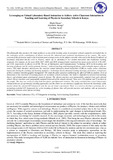| dc.contributor.author | Okono, Elijah | |
| dc.contributor.author | Abenga, Elizabeth | |
| dc.contributor.author | Ayoti, Caroline | |
| dc.date.accessioned | 2023-12-06T08:23:49Z | |
| dc.date.available | 2023-12-06T08:23:49Z | |
| dc.date.issued | 2023-11-15 | |
| dc.identifier.uri | https://doi.org/10.51867/ajernet.4.2.117 | |
| dc.identifier.uri | https://ajernet.net/ojs/index.php/ajernet/article/view/165 | |
| dc.identifier.uri | http://ir-library.mmust.ac.ke:8080/xmlui/handle/123456789/2430 | |
| dc.description.abstract | The philosophy that advances the study of physics as one of the learning areas in secondary schools cannot be overlooked due to the realization of the contributions of physics towards the industrial and vocational development of the country. The major concern of this particular study is the consistent poor average scores in the subject currently witnessed at the Kenya Certificate of Secondary Education (KCSE) level in Physics, which can be attributed to low student motivation and traditional teaching strategies. For instance, in the years 2016, 2017, 2018, and 2019, Kisumu County registered low mean scores of 4.23, 4.98, 4.67, and 4.10, respectively, in physics in KCSE. The use of Information and Communications Technology (ICT) in the teaching and learning of physics can be used to promote learners’ centered teaching and learning of physics and eventually improve physics scores. This study therefore underscores the need for virtual laboratory-based instruction (VLBI) to realize active classroom interaction during the teaching and learning of physics. Technology-based enhanced learning leverages all learners, irrespective of their economic and demographic background. The study therefore aimed at establishing the effect of VLBI on students’ level of interaction in the classroom in learning physics in secondary schools in Kenya. The study is supported by behaviorism learning theory and adopted quasi-experimental research designs. The physics teachers were purposefully sampled from each selected school. Physics teachers were purposefully sampled from each of the schools selected. There were 358 students and 72 teachers in the sample. The data was analyzed using both descriptive and inferential statistics. The study concluded that virtual laboratories enhanced the use of experimental teaching approaches and that there was no statistical significance between the knowledge of the teacher about the selected ICT framework and the use of virtual experiments. There is a need to develop a prototype for a technology-enriched ICT framework for active learning of physics that will provide teachers and students with an interactive platform to promote active physics learning. | en_US |
| dc.language.iso | en | en_US |
| dc.publisher | AFRICAN JOURNAL OF EMPIRICAL RESEARCH | en_US |
| dc.subject | Leveraging, Virtual, Laboratory-Based, Instruction, Achieve, Active, Classroom, Interaction, Teaching, Learning, Physics, Secondary, Schools | en_US |
| dc.title | Leveraging on Virtual Laboratory-Based Instruction to Achieve Active Classroom Interaction in Teaching and Learning of Physics in Secondary Schools in Kenya | en_US |
| dc.type | Article | en_US |

